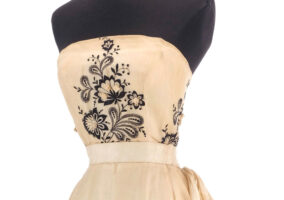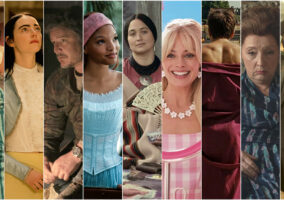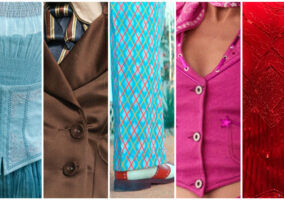![]() Pin
Pin
That’s right, darlings! We’re kicking off the Independence Day weekend by looking at the most iconic “All-American Girl” costume of all time! Which is ironic, because when you strip back the iconography, move past the legend of Garland, and ignore the very 1930s art direction of The Wizard of Oz, you’re left with a fairly simple and basic fantasy adventure story that tends to hit all the tropes of most classic fantasy adventure stories.
![]() Pin
Pin
Patriotism isn’t really the kind of thing one tends to associate with this movie, but we can assure you, there’s an undeniably American point of view represented in Dorothy Gale which not only spoke of the land she came from, but the times in which she lived and the fears that kept her people awake at night – and it’s all there in the goofily eye-popping art direction and costume design.
![]() Pin
Pin
But it’s true that most people think of the fantasy aspects of the story first. We did an entire Musical Mondays entry on this film by leaning into the idea that there’s barely any difference between Dorothy Gale and other Hero’s Quest figures like Luke Skywalker or Frodo Baggins. A young person is forced to leave home, venture out into a fantastic world full of awe-inspiring magic, amazing sights and terrifying dangers, where she picks up a collection of cohorts to help her on her quest; each of whom represents a different emotional state or philosophy to the main hero. A fellowship, if you will. In fact, we dubbed Dorothy, the Scarecrow, the Tin Woodsman and the Cowardly Lion “The Fellowship of the Pumps” when we wrote about them last.
![]() Pin
Pin
After all, the Ruby Slippers (because Sequined Pumps just doesn’t have the same ring to it) are undoubtedly the most famous pair of shoes in film history. And if we apply the criteria we’ve been using to establish iconic film looks (Halloween, cosplay and drag – if it’s well represented in those worlds that means it’s a costume that exists outside of its originating film; a costume that people recognize instantly no matter who’s wearing it), then Judy Garland’s Wizard of Oz costume of gingham pinafore and sequined pumps is easily a Top Five entry on the list of Most Iconic Film Costumes of All Time.
![]() Pin
Pin
To write about or analyze such a costume is a daunting task, and we’re going to do things a little differently with this one. When a film costume becomes this universally well-known; when it becomes a shorthand image not just of a character or a legendary actress, but of a concept, anyone who chooses to write about it comprehensively better know what they’re doing. We probably don’t, which is why we’re going to start off with a history lesson rather than analysis, using the words of auctioneers and museum docents to fill you in on the details.
![]() Pin
Pin
Metro-Goldwyn-Mayer, 1939. Comprising a blue and white gingham pinafore with a fitted bodice and a full skirt, two mother-of-pearl buttons on the front and two on the back, with a hook-and-eye closure at the back, bearing a bias label inscribed in script, “Judy Garland,” and a short cream-colored cotton blouse with a high neck, pale blue rickrack trim at the cuffs and neck, hook-and-eye and snap closure at the back, reinforced shoulders, and a bias label inscribed, “Judy Garland / 4461.”
Provenance: Christie’s New York, Collectibles, September 30-October 1, 1981, lot 742, accompanied by a copy of the catalog.
This blouse and pinafore were retained by Kent Warner, the costume collector employed by David Weisz Co. to help organize the 1970 MGM Auction who subsequently cherry-picked many of the best pieces for himself. He also took home a pair of the Ruby Slippers where were sold in the same 1981 Christie’s auction and subsequently resold in 2012 to the Academy of Motion Picture Arts and Sciences. One of the very few complete Dorothy costumes still in existence, and a true icon of classic Hollywood.
It sold for $1.56 million. Ever notice that several parts of the gingham (straps, bustline, sash and a strip near the hem) are cut on the bias, giving the pattern a more discordant feel than you might notice consciously?
![]() Pin
Pin
![]() Pin
Pin
On a spring day in 1970, as MGM studios was clearing out its famous backlot property in Culver City in advance of its sale to a developer, a costumes worker named Kent Warner slipped into the deep storage on the third floor. He crept up the stairs to the lady’s character wardrobe.
There were several sets of ruby slippers on the shelf, plus a curly-toed test pair. Warner had been told to destroy all but one. The single remaining pair were to be offered for sale at the seminal multi-day MGM Studios auction, where 350,000 costumes were to be sold, including the loin cloth worn by Johnny Weissmuller in Tarzan and Gene Kelly’s sailor hat from the 1949 film On the Town.
Warner picked out a pair of ruby slippers for the sale. But on the sly, he stuffed the others in a bag and walked them off the lot.
Each shoe had 2,300 sequins. Estimates vary about how many shoes the costume-makers actually made, but probably around 10. They made one pair a half size larger for Garland to wear in the afternoon after her feet got swollen.
Warner parted with his pair in 1981 for just $12,000 to an anonymous buyer. He was one of the first men on the west coast diagnosed with AIDS, and he was struggling to pay his medical bills. He died in 1984. In 2000, another pair of ruby slippers sold for $666,000 at an auction.
Today, we know that the Smithsonian’s Ruby Slippers are a mismatched pair, with a half-size difference.
![]() Pin
Pin
The fact that a gay man stole the ruby slippers and then sold them years later to pay for his AIDS treatment before dying is just about the most poignant goddamn thing anyone could say about an iconic film costume. Judy was always there for the gays and vice versa, unto death – and beyond it. In a way, we almost want to stop right there and let that stand as all that needs to be said about this costume, but that would do a minor disservice to the film’s costume designer, the legendary Adrian, and what he accomplished with this design.
![]() Pin
Pin
![]() Pin
Pin
Looking at the particulars and details, we are struck by the almost underwhelming simplicity of the costume design, which is kind of deceptive, because the more you look at it, the more you see. As we noted above, the gingham is set at odds with itself throughout the design. The collar and sleeves are both embellished with rickrack. The mother of pearl buttons, satin hair ribbons, and the rather fussy ruching of the blouse are a bit fanciful for a girl who’s just hanging around her farm on a stormy day, dreaming about rainbows and trying to save her dog from the pound. All of these little details add up to make a simple prairie dress look just fanciful enough to register for Technicolor.
![]() Pin
Pin
But there’s no denying that – little details aside – the overall feel of the costume is one of precious plainness. Cute and fanciful, representing the American ideal of the Heartland Girl. Two things to put some of this in context: This is the only costume Judy Garland wore in the Wizard of Oz. This isn’t entirely unheard of for Hero’s Quest protagonists and their films (again: think Luke Skywalker in the first Star Wars and Frodo for almost the entire trilogy of Lord of the Rings). From a practical perspective, it can allow the filmmaker to show the passing of time or the toll the quest is taking by having the costume degrade or get dirtier over the course of the film. From a symbolic perspective, leaving your hero in one costume for the entire length of the film can serve a bunch of different goals.
![]() Pin
Pin
First and most obvious is that it remains a constant reminder of the world of the hero’s origin; the world they had to leave and/or were dying to leave to explore what was beyond. In the case of Frodo or Dorothy, it’s a neverending hum in the background of every scene; an undertone that reminds you that the hero just wants to go back to where they came from.
![]() Pin
Pin
![]() Pin
Pin
Surrounded by colorful figures in outlandish costumes, Dorothy never stops looking like a perfect exemplar of what she is: a Kansas farm girl from the early 20th Century. This also underlines all of her interactions and identifies her as a quintessential “fish out of water” character.
![]() Pin
Pin
Two other things to remember when considering how basic and simple this costume is: Dorothy Gale was a popular children’s book character from a long-established book series that stretched back nearly 40 years and Judy Garland was in the midst of extremely heavy buzz as MGM’s next huge star. To the first point, the costume’s iconic simplicity speaks to the children’s lit origins of the character as well as the need to keep the visuals as simple as possible so as not to interfere with whatever image the audience already had of the character in their heads. To the second point, the simple design serves as a sort of introduction to Garland, who was in her first starring role. This is similar to how Vivien Leigh was first introduced in Gone With the Wind, in the simplest, most precious and fanciful white gown. In both instances, the costume almost seems to serve as a sort of spotlight on the debut of the character and the actress playing her. Here she is, America. Here’s your girl from the heartland, your childhood heroine, the one with the voice everyone’s talking about.
![]() Pin
Pin
So all of that – all that gingham and ruching, sequins and rickrack – it all serves to tell you who Dorothy is, where she came from, what her whole story’s about and why you should pay special attention to the talented girl playing her. But if you want to get all semiotic and film-school about it, you could also say that Dorothy’s red, white and blue costume is not just a symbol of her status as the 20th Century ideal of the All-American Girl, but an embodiment of the hopes and fears of an America just starting to see itself out of the Great Depression and facing the looming prospect of another war in Europe.
![]() Pin
Pin
![]() Pin
Pin
![]() Pin
Pin
What is Oz but a faraway land with strange customs, a world of warring factions and uneasy alliances, a world with political prisoners and despots, a world of castles and crown-wearers? Oz, with all its wonder and castles and weirdness and danger is Europe to the eyes of an American audience in 1939. A place you might want to visit, but you will definitely want to come home when you’ve seen enough.
![]() Pin
Pin
So, having established that Dorothy represents the hopes of America and Oz represents the fears Americans have of European discord, please allow us to introduce:
![]() Pin
Pin
Hitler.
You heard us.
![]() Pin
Pin
![]() Pin
Pin
![]() Pin
Pin
Look, you have to remember that films exist within the times they’re made and are brought forth into creation by people who lived in those times. Just as we can look at Scarlett O’Hara’s white dress and speak of it as a symbol of white supremacy, knowing full well that wasn’t the conscious intent of its designer or the film’s director, we can also look at Margaret Hamilton’s sneering, histrionic, hand gesturing portrayal of the Wicked Witch of the West and notice that, whether she intended it or not, she sure does act a lot like Hitler in this movie.
![]() Pin
Pin
The Hitler that Americans were watching on newsreels, giving shrieking, histrionic speeches with a lot of gesticulating and sneering.
![]() Pin
Pin
And once we make that leap, it’s very easy to see her European-style castle, disturbingly obedient troops, and predilection for aerial bombardment of her enemies as representative of the fears that were foremost in the minds of Americans at the time the movie was made. By refusing to give the ruby slippers to the Wicked Witch of the West, Dorothy is literally keeping the red, white and blue together. And by standing with her allies, she’s able to defeat the ultimate despot by proving to relieved audience members that they can rest easy, because Hitler can be defeated with a bucket of water.
![]() Pin
Pin
And then all the grateful peasants, laborers and crowned heads of Europe send the All-American girl back home, grateful for her help in defeating fascism, awed by her dedication to the simple homespun pleasures of American rural life.
![]() Pin
Pin
WE ARE NOT OVERTHINKING THIS, DAMMIT. DOROTHY DEFEATED HITLER AND STANDS WITH LUKE AND FRODO AS ONE OF THE GREATEST EXAMPLARS OF THE HERO’S QUEST IN FILM AND LITERARY HISTORY.
![]() Pin
Pin
And she did it in heels, bitches.
[Stills: Metro Goldwyn Mayer via Tom and Lorenzo, bonhams.com, smithsonianmag.com]
T Lo Talk “Legendary Children” and Audiobook Recording Next Post:
Yea or Nay: Michael Kors Cece Extra-Small Tie Dye Leather Crossbody Bag
-
 Pin
Pin
Audrey Hepburn’s Iconic SABRINA Gown Designed by Givenchy to Be Auctioned
-
 Pin
Pin
The 26th CDGA (Costume Designers Guild Awards) Nominees Announced!
-
 Pin
Pin
T LO’s Fave Movie Costumes of 2023, Part ONE
Please review our Community Guidelines before posting a comment. Thank you!
